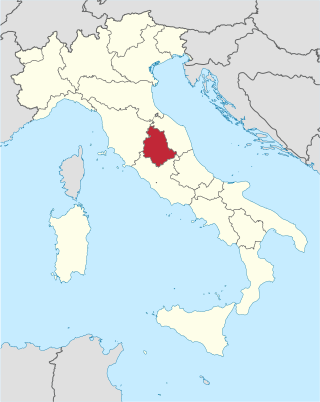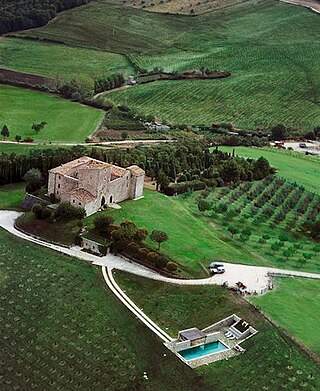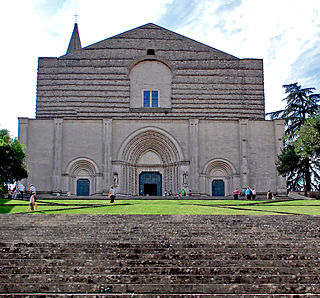Related Research Articles

Umbria is a region of central Italy. It includes Lake Trasimeno and Marmore Falls, and is crossed by the River Tiber. It is the only landlocked region on the Apennine Peninsula. The regional capital is Perugia.

Saint Valentine was a 3rd-century Roman saint, commemorated in Western Christianity on February 14 and in Eastern Orthodoxy on July 6. From the High Middle Ages, his Saints' Day has been associated with a tradition of courtly love. He is also a patron saint of Terni, epilepsy and beekeepers. Saint Valentine was a clergyman – either a priest or a bishop – in the Roman Empire who ministered to persecuted Christians. He was martyred and his body buried on the Via Flaminia on February 14, which has been observed as the Feast of Saint Valentine since at least the eighth century.

Todi is a town and comune (municipality) of the province of Perugia in central Italy. It is perched on a tall two-crested hill overlooking the east bank of the river Tiber, commanding distant views in every direction. It was founded in antiquity by the Umbri, at the border with Etruria; the family of Roman Emperor Trajan came from Todi.

A reliquary is a container for relics. A portable reliquary may be called a fereter, and a chapel in which it is housed a feretory.

Saint Anastasia is a Christian saint and martyr who died at Sirmium in the Roman province of Pannonia Secunda. In the Eastern Orthodox Church, she is venerated as St. Anastasia the Pharmakolytria, i.e. "Deliverer from Potions".

August 12 - Eastern Orthodox liturgical calendar - August 14
Saints Marius, Martha, Audifax, and Abachum were, according to their largely legendary passio of the 6th century, four saints of the same family. They came from Persia to Rome, and were martyred in 270 for sympathizing with Christian martyrs and burying their bodies. Some ancient martyrologies place the date of their death between 268 and 270, during the reign of Claudius II, although there was no persecution of Christians during this time.

Jacopone da Todi, O.F.M. was an Italian Franciscan friar from Umbria. He wrote several laude in the local vernacular. He was an early pioneer in Italian theatre, being one of the earliest scholars who dramatised Gospel subjects.

Saint Praxedes is a traditional Christian saint of the 2nd century. Her name is sometimes rendered as Praxedis (Πραξηδίς) or Praxed.

Saint Hermes, born in Greece, died in Rome as a martyr in 120, is venerated as a saint by the Catholic Church and the Eastern Orthodox Church. His name appears in the Martyrologium Hieronymianum as well as entries in the Depositio Martyrum (354). There was a large basilica over his tomb that was built around 600 by Pope Pelagius I and restored by Pope Adrian I. A catacomb in the Salarian Way bears his name.

Saint Domnius was a Bishop of Salona around the year 300, and is venerated as the patron of the nearby city of Split in modern Croatia. Salona was a large Roman city serving as capital of the Province of Dalmatia. Saint Domnius was martyred with seven other Christians in the persecutions of the Emperor Diocletian. He was born in Antioch, in modern-day Turkey but historically in Syria, and beheaded in 304 at Salona.

Simon Rinalducci of Todi was a famous Italian Augustinian friar and preacher of the 13th century.

Saint Fortunatus was a 6th-century bishop of Todi. According to tradition, he defended Todi during a Gothic siege. He is the patron saint of Todi. He is praised by Gregory the Great, who calls him a man of great virtue who took great care in attending to the sick. Gregory, who was born around the time that Fortunatus died, was greatly interested in Fortunatus' life. Gregory writes that "a certain poor old man was brought to me –because I always love to talk with such men- of whom I inquired his country, and hearing that he was of the city of Todi, I asked him whether he knew Bishop Fortunatus. He said he knew him very well. 'Then I beseech you,' said I, 'tell me whether you know of any miracles that he did, and, since I am very desirous to know, explained to me what manner of man he was.'"

The Todi Castle is a former medieval Castle located 15 km south of the town of Todi, to the east side of the town of Collelungo, which is part of the Municipality of Baschi, near Terni, in Umbria, Italy.

October 13 - Eastern Orthodox liturgical calendar - October 15

Saint Illuminata was an early Christian woman, martyred c. 320 during the persecutions of Diocletian, and venerated as a Christian saint.

Stephen is traditionally venerated as the protomartyr or first martyr of Christianity. According to the Acts of the Apostles, he was a deacon in the early Church at Jerusalem who angered members of various synagogues by his teachings. Accused of blasphemy at his trial, he made a speech denouncing the Jewish authorities who were sitting in judgment on him and was then stoned to death. Saul of Tarsus, later known as Paul, a Pharisee and Roman citizen who would later become a Christian apostle, participated in Stephen's martyrdom.

San Fortunato is a Gothic- and Renaissance-style, Roman Catholic church located on Piazza Umberto I #6 in the historic center of Todi, province of Perugia, region of Umbria, Italy.

Santi Simone e Giuda is a Gothic-romanesque-style, deconsecrated Roman Catholic church located on Via Brignoni #40 in Spoleto, Province of Perugia, Umbria, Italy. It was built in the 13th century as a Franciscan church and adjacent convent.
San Filippo Benizzi, formerly Santa Maria delle Grazie is a Roman Catholic sanctuary church and convent on Via Giacomo Matteoti, just inside the Porta Romana and across the Street from San Niccolo, in the center of Todi, province of Perugia, region of Umbria, Italy.